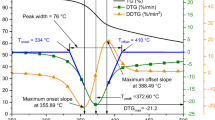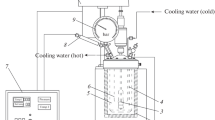Abstract
The product yields of hydrothermal carbonization of wheat straw as well as the degree of carbonization are quantified as functions of process parameters by using a severity approach. The process severity was calculated from temperature, retention time, and catalyst concentration. Data gained from batch experiments (190–245 °C, 150–570 min) were used to fit the model parameters. By these models, basing on few selected reaction conditions, a wide range of process conditions can be covered and the yields for the solid, solved organic, and gaseous product phase can be predicted. Moreover, the paper delivers model equations for the prediction of the H/C and O/C ratios for the solid product phase. Such model equations can be used for process optimization and for valid LCA calculations.





Similar content being viewed by others
References
Bergius F (1932) Chemical reactions under high pressure. Nobel Lecture
Danso-Boateng E, Shama G, Wheatley AD, Martin SJ, Holdich RG (2015) Hydrothermal carbonisation of sewage sludge: effect of process conditions on product characteristics and methane production. Bioresour Technol 177:318–27
Guiotoku M, Rambo CR, Hotza D (2014) Charcoal produced from cellulosic raw materials by microwave-assisted hydrothermal carbonization. J Therm Anal Calorim 117(1):269–75
Reza MT, Wirth B, Lueder U, Werner M (2014) Behavior of selected hydrolyzed and dehydrated products during hydrothermal carbonization of biomass. Bioresour Technol 169:352–61
Yan W, Hoekman SK, Broch A, Coronella CJ (2014) Effect of hydrothermal carbonization reaction parameters on the properties of hydrochar and pellets. Environ Prog Sustain Energy 33(3):676–80
Reza MT, Yan W, Uddin MH, Lynam JG, Hoekman SK, Coronella CJ et al (2013) Reaction kinetics of hydrothermal carbonization of loblolly pine. Bioresour Technol 139:161–9
Lynam JG, Reza MT, Vasquez VR, Coronella CJ (2012) Effect of salt addition on hydrothermal carbonization of lignocellulosic biomass. Fuel 99:271–3
Reza MT, Lynam JG, Uddin MH, Coronella CJ (2013) Hydrothermal carbonization: fate of inorganics. Biomass Bioenergy 49:86–94
Wiedner K, Naisse C, Rumpel C, Pozzi A, Wieczorek P, Glaser B (2013) Chemical modification of biomass residues during hydrothermal carbonization—what makes the difference, temperature or feedstock? Org Geochem 54:91–100
Roman S, Nabais JMV, Laginhas C, Ledesma B, Gonzalez JF (2012) Hydrothermal carbonization as an effective way of densifying the energy content of biomass. Fuel Process Technol 103(SI):78–83
Hoekman SK, Broch A, Robbins C (2011) Hydrothermal carbonization (HTC) of lignocellulosic biomass. Energy Fuel 25(4):1802–10
Mumme J, Eckervogt L, Pielert J, Diakite M, Rupp F, Kern J (2011) Hydrothermal carbonization of anaerobically digested maize silage. Bioresour Technol 102(19):9255–60
Ruyter HP (1982) Coalification model. Fuel 61(12):1182–7
Abatzoglou N, Chornet E, Belkacemi K, Overend RP (1992) Phenomenological kinetics of complex systems: the development of a generalized severity parameter and its application to lignocellulosics fractionation. Chem Eng Sci 47(5):1109–22
Janga KK, Øyaas K, Hertzberg T, Moe ST (2012) Application of a pseudo-kinetic generalized severity model to the concentrated sulfuric acid hydrolysis of pinewood and aspenwood. BioResources 7(3).
Kruse A, Badoux F, Grandl R, Wüst D (2012) Hydrothermale Karbonisierung: 2. Kinetik der Biertreber-Umwandlung Chemie Ing Tech 84(4):509–12
Kieseler S, Neubauer Y, Zobel N (2013) Ultimate and proximate correlations for estimating the higher heating value of hydrothermal solids. Energy Fuels 27(2):908–18
Forchheim D, Hornung U, Kruse A, Sutter T (2014) Kinetic modelling of hydrothermal lignin depolymerisation. Waste Biomass Valor 5(6):985–94
Funke A, Ziegler F (2010) Hydrothermal carbonization of biomass: a summary and discussion of chemical mechanisms for process engineering. Biofuels, Bioprod Bioref 4(2):160–77
Suwelack KU, Wüst D, Fleischmann P, Kruse A (2015) Prediction of gaseous, liquid and solid mass yields from hydrothermal carbonization of biogas digestate. Biomass Conv Bioref (N.N.)
Mott RA, Spooner CE (1940) The calorific value of carbon in coal: the dulong relationship. Fuel 19(10, 11):226–31, 242–251
Ruiz HA, Rodríguez-Jasso RM, Fernandes BD, Vicente AA, Teixeira JA (2013) Hydrothermal processing, as an alternative for upgrading agriculture residues and marine biomass according to the biorefinery concept: a review. Renew Sust Energ Rev 21:35–51
Montane D, Salvade J, Farriol X, Jollez P, Chornet E (1994) Phenomenological kinetics of wood delignification: application of a time-dependent rate constant and a generalized severity parameter to pulping and correlation of pulp properties. Wood Sci Technol 28(6)
Titirici M, Thomas A, Antonietti M (2007) Back in the black: hydrothermal carbonization of plant material as an efficient chemical process to treat the CO2 problem? New J Chem 31(6):787
Xu Q, Qian Q, Quek A, Ai N, Zeng G, Wang J (2013) Hydrothermal carbonization of macroalgae and the effects of experimental parameters on the properties of hydrochars. ACS Sustain Chem Eng 1(9):1092–101
Stemann J, Putschew A, Ziegler F (2013) Hydrothermal carbonization: process water characterization and effects of water recirculation. Bioresour Technol 143:139–46
del Río, José C, Rencoret J, Prinsen P, Martínez ÁT, Ralph J, Gutiérrez A (2012) Structural characterization of wheat straw lignin as revealed by analytical pyrolysis, 2D-NMR, and reductive cleavage methods. J Agric Food Chem 60(23):5922–35
Tambone F, Genevini P, D’Imporzano G, Adani F (2009) Assessing amendment properties of digestate by studying the organic matter composition and the degree of biological stability during the anaerobic digestion of the organic fraction of MSW. Bioresour Technol 100(12):3140–2
Kruse A, Grandl R (2015) Hydrothermale Karbonisierung: 3. Kinetisches Modell Chemie Ing Tech 87(4):449–56
Acknowledgments
We thank Dr. Joachim Schulze and Dr. Martin Brüchert from Fraunhofer Institute for Technological Trend Analysis INT in Euskirchen, Germany, for the support of this work and all reviewers for their valuable comments.
Author information
Authors and Affiliations
Corresponding author
Rights and permissions
About this article
Cite this article
Suwelack, K., Wüst, D., Zeller, M. et al. Hydrothermal carbonization of wheat straw—prediction of product mass yields and degree of carbonization by severity parameter. Biomass Conv. Bioref. 6, 347–354 (2016). https://doi.org/10.1007/s13399-015-0192-4
Received:
Revised:
Accepted:
Published:
Issue Date:
DOI: https://doi.org/10.1007/s13399-015-0192-4




